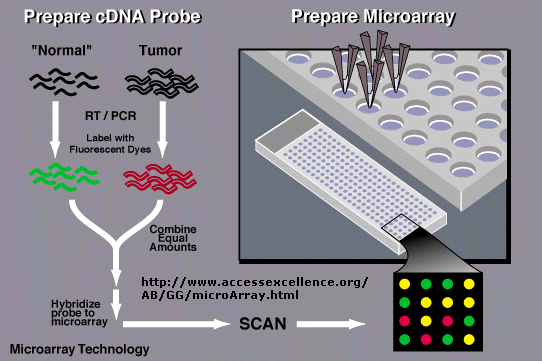Biochemistry Online: An Approach Based on Chemical Logic

CHAPTER 5 - BINDING
E: MODERN METHODS IN DRUG DEVELOPMENT
BIOCHEMISTRY - DR. JAKUBOWSKI
Last Updated: 03/31/16
|
Learning Goals/Objectives for Chapter 5E: After class and this reading, students will be able to
|
E6. DNA Binding and Genomic Analyses
Huge numbers (100,000 to 1 million) of different DNA molecules can be covalently attached to silicon or glass chips, as described above for the peptides. These sequences are located at specific x,y coordinates on the chip. DNA probes can then be made from cells (by adding reverse transcriptase to isolated mRNA. forming cDNA), which are then labeled with a fluorescent molecule. Easier yet, mRNA can be isolated from the cells and labeled with a fluorophore. When added to the chip, they will bind through complementary H-bond interactions to specific complementary DNA on the chip. Using this technique, an individual's entire genome could be analyzed in a short amount of time. For example, mutations in certain genes associated with cancer might be detected by fluorescent-DNA probes made from a possible mutant gene to specific DNA molecules in the chip that were designed to bind to mutant probes.
In an amazing variation, mRNA can be extracted from two different cells, a control and a tumor cell. The control mRNA can be labeled with a green fluorophore, while the tumor cell mRNA can be labeled with a red fluorphore. They can both be added to the chip containing a library of human genes. If the gene is expressed in both cell types, both types of labeled mRNA will bind and the spot on the chip will appear yellow.
If the gene is not expressed in either tissue, the spot will appear black. Genes that are only expressed in tumor cells will appear red and in control cells green. In a single experiment, the differential expression of genes in tumor cells can be determined. In this way, tumor-specific proteins can be identified, which could lead to the development of a vaccine against those tumor antigens. A typical microarray analysis for this type of experiment is shown below. (from Nature, 403, 699 (2000).
Figure:
![]() Detection
of Differential Gene Expression in Tumors and Normal Cells Using Microarray
Chip
Detection
of Differential Gene Expression in Tumors and Normal Cells Using Microarray
Chip

Array technologies have continued to evolve. Affymetrix has developed a array chip that contains over 38,000 genes, representing the entire human genome.
Navigation
Return to 5E. Modern Methods in Drug Development Sections
Return to Biochemistry Online Table of Contents
Archived version of full Chapter 5E: Modern Methods in Drug Development

Biochemistry Online by Henry Jakubowski is licensed under a Creative Commons Attribution-NonCommercial 4.0 International License.